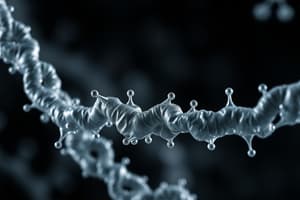Podcast
Questions and Answers
Carbohydrates are organic molecules that do not dissolve easily in water.
Carbohydrates are organic molecules that do not dissolve easily in water.
False (B)
Proteins are specialized lipids that speed up chemical reactions in cells.
Proteins are specialized lipids that speed up chemical reactions in cells.
False (B)
Nucleic acids contain the instructions for building proteins based on the sequence of nucleotides.
Nucleic acids contain the instructions for building proteins based on the sequence of nucleotides.
True (A)
Lipids are generally soluble in aqueous solutions.
Lipids are generally soluble in aqueous solutions.
Enzymes lower the activation energy required for chemical reactions to occur.
Enzymes lower the activation energy required for chemical reactions to occur.
Which class of biomolecules serves as the structural components of cells, acts as transporters, and is essential for biological catalysis as enzymes?
Which class of biomolecules serves as the structural components of cells, acts as transporters, and is essential for biological catalysis as enzymes?
What is the primary function of carbohydrates in living organisms?
What is the primary function of carbohydrates in living organisms?
Which biomolecules are hydrophobic, act as a source of stored energy, and form membranes separating cells from their environments?
Which biomolecules are hydrophobic, act as a source of stored energy, and form membranes separating cells from their environments?
What is the role of nucleic acids in cells?
What is the role of nucleic acids in cells?
Which biomolecules lower the activation energy required for chemical reactions to occur in cells?
Which biomolecules lower the activation energy required for chemical reactions to occur in cells?
What is the primary function of proteins in living organisms?
What is the primary function of proteins in living organisms?
Which biomolecule serves as the main energy source for living organisms?
Which biomolecule serves as the main energy source for living organisms?
What is the main structural difference between DNA and RNA?
What is the main structural difference between DNA and RNA?
Which biomolecule is commonly known for its waterproofing properties in cells?
Which biomolecule is commonly known for its waterproofing properties in cells?
In the context of biological processes, what is the primary role of enzymes?
In the context of biological processes, what is the primary role of enzymes?
Flashcards are hidden until you start studying
Study Notes
Biomolecules: Carbohydrates, Proteins, Nucleic Acids, Lipids, and Enzymes
Biomolecules are essential organic molecules found in living organisms, ranging from simple carbohydrates to large, complex proteins. They play crucial roles in maintaining the structure, function, and regulation of cells. Here, we explore the five main categories of biomolecules: carbohydrates, proteins, nucleic acids, lipids, and enzymes.
Carbohydrates
Carbohydrates are organic molecules composed primarily of carbon, hydrogen, and oxygen atoms. They serve as primary energy sources and structural components for cells. Carbohydrates can be categorized into monosaccharides (simple sugars), disaccharides (two sugar molecules bonded together), oligosaccharides (a few sugar molecules), and polysaccharides (many sugar molecules joined together).
Proteins
Proteins are large, complex molecules made up of amino acids. They have various functions, including serving as structural components of cells, acting as transport molecules, catalyzing chemical reactions, forming antibodies and hormones, and regulating gene expression. Proteins are formed when amino acids are linked together by peptide bonds, resulting in a long polymer. The specific sequence of amino acids determines the protein's shape and its ability to carry out certain functions.
Nucleic Acids
Nucleic acids, specifically deoxyribonucleic acid (DNA) and ribonucleic acid (RNA), store an organism's genetic code. DNA contains the instructions for building proteins based on the sequence of nucleotides, which determine the amino acid sequence of proteins. Both DNA and RNA contain a base pair system where each base pairs with only one other base (Adenine-Thymine and Guanine-Cytosine in DNA; Adenine-Uracil and Guanine-Cytosine in RNA).
Lipids
Lipids are organic molecules that do not dissolve easily in water. They serve multiple functions, such as providing energy storage, acting as components of cell membranes, and functioning as signaling molecules. Lipids are generally insoluble in aqueous solutions, making them essential for maintaining the integrity of cell membranes.
Enzymes
Enzymes are specialized proteins that speed up chemical reactions in cells, lowering the activation energy required for chemical reactions to occur. They are essential for nearly all biological processes, including digestion, respiration, and protein synthesis. The rate at which a reaction proceeds depends on the enzyme concentration, substrate concentration, temperature, pH, and the presence of activators or inhibitors.
Studying That Suits You
Use AI to generate personalized quizzes and flashcards to suit your learning preferences.




